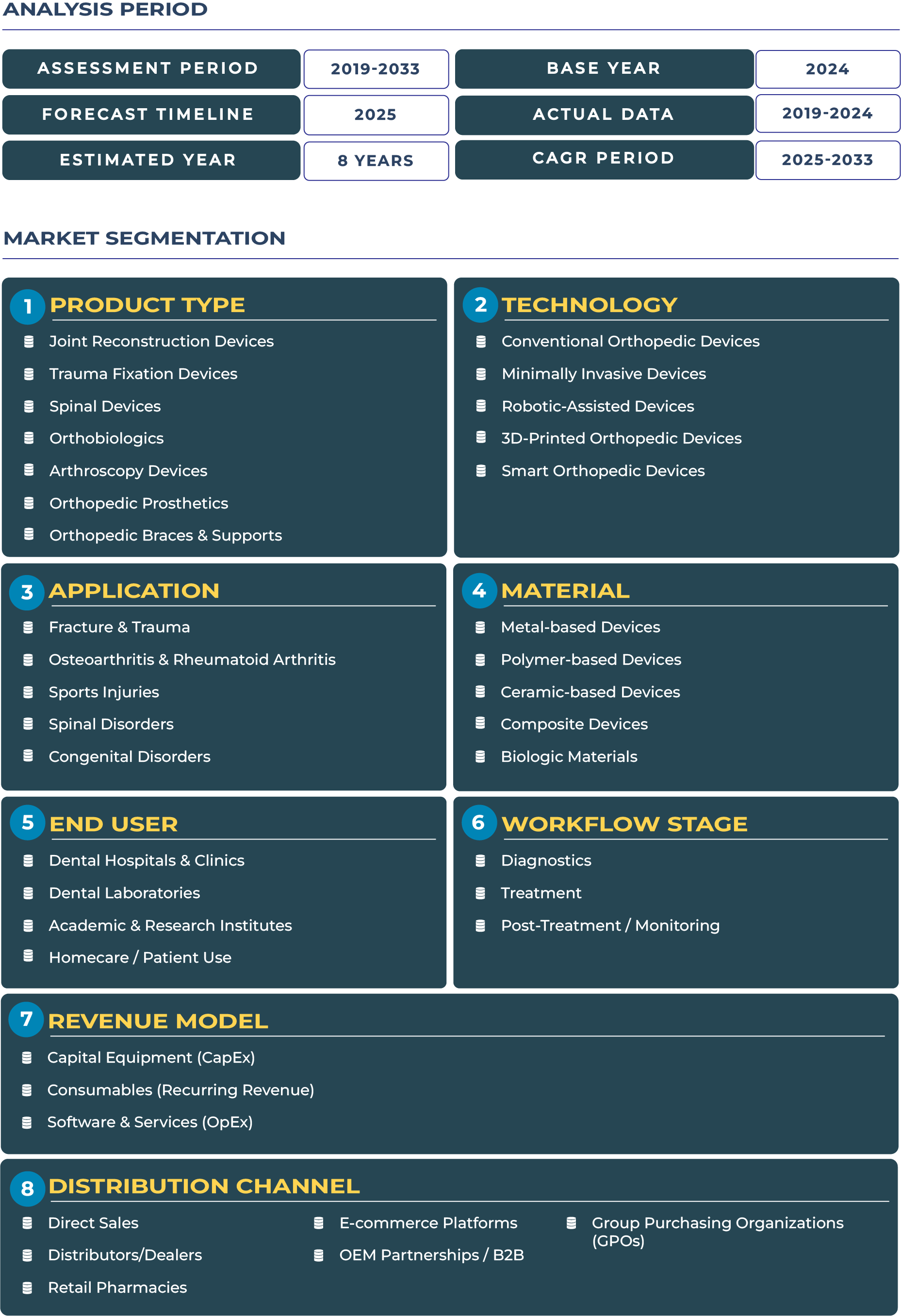Report Format:
![]()
![]() |
Pages: 110+
|
Pages: 110+
Brazil Orthopedic Devices Market: Largest LATAM Hub Driving Healthcare Transformation
Brazil stands as the largest orthopedic devices market in Latin America, driven by a combination of rising healthcare investments, demographic shifts, and evolving private healthcare demand. The nation’s aging population is steadily expanding, pushing demand for orthopedic implants, trauma fixation devices, and spinal care technologies. With private hospitals expanding advanced surgical capacities in cities like São Paulo and Rio de Janeiro, orthopedic devices are no longer restricted to elite patient groups but are increasingly accessible across multiple income segments. By 2025, the Brazil orthopedic devices market is projected at USD 1.46 billion, reaching USD 1.96 billion by 2033, according to DataCube Research. This trajectory is reinforced by Brazil’s role as a regional leader in healthcare reforms, creating a favorable ecosystem for innovation, surgical device adoption, and orthobiologics integration.
Rising Demand Anchored by Aging Demographics and Private Healthcare Investment
Brazil Orthopedic Devices industry demonstrates consistent growth supported by strong private healthcare penetration and a rapidly aging society. The increasing prevalence of musculoskeletal disorders and rising sports-related injuries further contribute to a resilient demand base. Joint reconstruction devices, particularly hip and knee implants, are among the fastest-growing categories due to lifestyle-related conditions and urban sedentary patterns. Additionally, the Brazilian Unified Health System (Ministério da Saúde) is extending coverage for essential orthopedic procedures, which balances public affordability challenges with private hospital-driven innovation. The orthopedic devices ecosystem is benefiting from this dual-track system, where high-tech implants and prosthetics dominate private sector procedures while trauma fixation and basic implants see steady uptake in public facilities. These parallel trends reinforce Brazil’s market outlook, ensuring steady expansion across all orthopedic device categories in the forecast horizon.
Growth Catalysts and Barriers in the Brazil Orthopedic Devices Market
Strong private hospital networks and growing middle-class drive consistent adoption
Brazil Orthopedic Devices sector is expanding due to its advanced network of private hospitals, which continue to invest in modern surgical centers and robotics-assisted orthopedic solutions. A growing middle-class population has heightened demand for elective procedures such as knee replacement, boosting growth in joint reconstruction and arthroscopy segments. The country’s established medical training hubs further enhance physician access to cutting-edge technologies, reinforcing patient confidence in advanced orthopedic procedures. Urban hospitals in São Paulo and Brasília are leading in minimally invasive surgeries, expanding access to high-value orthopedic devices.
Economic volatility and import tax structure remain persistent obstacles
Despite its market leadership, the Brazil orthopedic devices landscape faces systemic challenges. Currency volatility impacts procurement costs, creating uncertainty for both public and private healthcare providers. High import taxes on advanced devices, such as customized spinal implants and prosthetics, increase pricing pressure and reduce affordability across broader patient populations. Furthermore, regional inequalities in healthcare access persist, with rural areas facing delayed orthopedic interventions compared to metropolitan centers. These barriers necessitate innovative strategies such as localized production and tiered pricing models to address market disparities.
Shifting Trends and Untapped Opportunities Reshaping Brazil Orthopedic Devices Industry
Growing role of ambulatory centers and sports medicine investments
Brazil Orthopedic Devices market is witnessing a notable trend with the growth of ambulatory surgery centers (ASCs), enabling faster orthopedic procedures at lower costs. Sports medicine, particularly in a football-dominant nation, is driving adoption of arthroscopy devices and advanced joint repair implants. Major urban centers are building specialized orthopedic institutes focusing on minimally invasive procedures, further expanding the orthopedic devices ecosystem. These developments signal a broader trend toward efficient, patient-friendly treatment models.
Local manufacturing and strategic partnerships unlock fresh opportunities
Key opportunities in the Brazil orthopedic devices industry lie in strengthening local manufacturing to bypass heavy import tariffs. Domestic OEMs are scaling production of trauma fixation devices and cost-effective orthopedic prosthetics, making advanced care more affordable. Distributor partnerships and joint ventures with international players further enhance regional penetration. Additionally, clinical training programs for orthopedic surgeons are emerging as critical enablers of adoption, ensuring Brazilian hospitals remain aligned with global orthopedic innovations. These developments not only improve affordability but also build long-term resilience for the orthopedic devices sector.
Competitive Landscape: Strategic Collaborations and Local Manufacturing Redefining Brazil’s orthopedic devices market
The competitive landscape of Brazil Orthopedic Devices industry is shaped by a mix of international leaders and strong domestic manufacturers. Global players such as Johnson & Johnson MedTech maintain a significant footprint, while Brazilian companies expand their role in trauma and fixation segments. Recent developments highlight local joint ventures designed to reduce import dependencies and align with national industrial policies. For instance, international OEMs are partnering with domestic distributors to establish manufacturing and training hubs in São Paulo, leveraging Brazil’s medical infrastructure to serve both local and regional demand. Moreover, the focus on “value implant families” tailored to different income brackets highlights an adaptive strategy to Brazil’s price-sensitive orthopedic landscape. These strategic shifts indicate a more sustainable, inclusive, and competitive orthopedic devices sector in the country.







